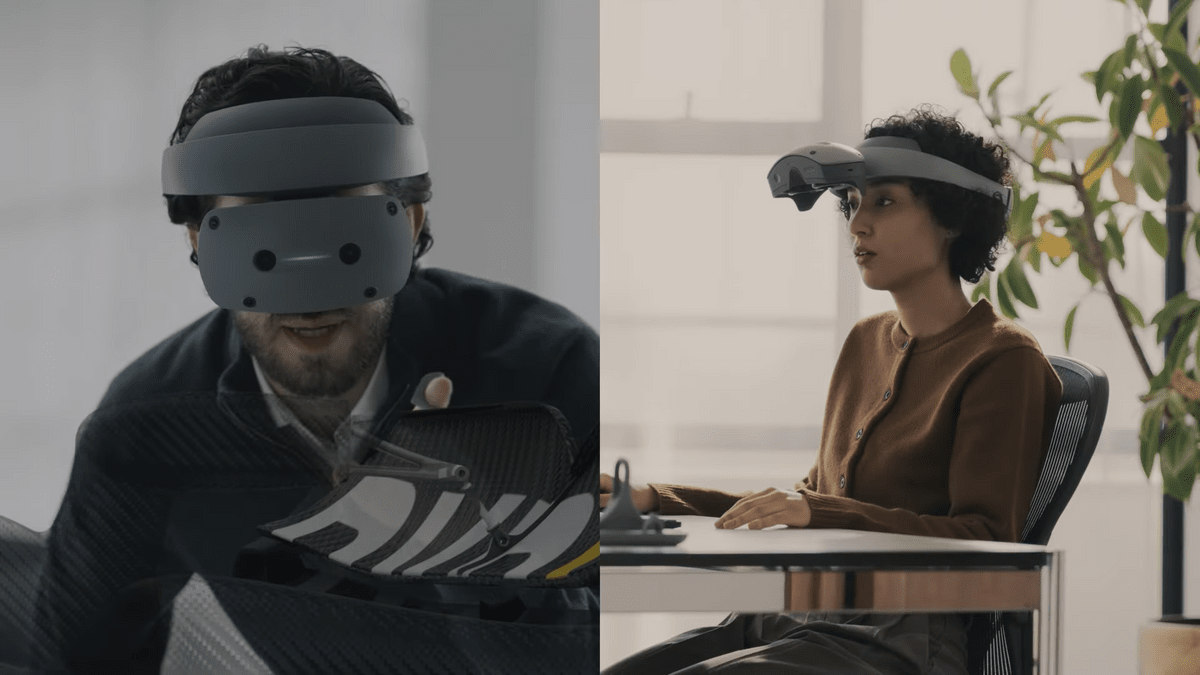Sony is devising its own spatial headset tailor made for video game creation to take on Apple Vision Pro

The world is abuzz with innovation as CES 2024 nears its closing time, but one exciting piece of technology out of Sony remains an interesting topic of discussion as the Apple Vision Pro soon hits the market.
In the midst of its CES showcase, Sony gave a sneak peak of an upcoming mixed reality headset it’s calling a “spatial content creation” platform. It’s slated for official release later this year and, unlike its Apple-based rival, is geared more for professional use-cases specifically in the 3D modeling sphere.
Sony’s headset sports somewhat similar specs to the Vision Pro, main among them being its dual 1.3” 4K OLED microdisplays, while other additions, like bespoke controllers, a Qualcomm XR2+ Gen 2 processor, and “proprietary rendering technology,” might allow it an interesting edge in the market.
Could Sony give Apple a run for its money with its own spatial computer design? It’s an important question as the MR tech space heats up with avid contenders like Samsung and Google likewise jumping into the fray with their own headset design that could leave Apple’s Vision Pro in the dust.
Game creation at your fingertips

On stage amid its CES 2024 presentation, Sony CEO Kenichiro Yoshida delightedly introduced to the crowd “a new solution for spatial content creation.” The MR headset, which takes a similar minimalist design ethos to that of the PSVR2 and adds a touch of industrial gray, is being marketed more toward 3D modeling professionals as opposed to general consumers.
Equipped with a Qualcomm Snapdragon XR2+ Gen 2 chip, two 4K OLED microdisplays, a wand-like controller, another much smaller ring-like device, and 6 total cameras and sensors, Sony’s spatial headset will offer users a “crisp viewing experience” with incredible space tracking. Yoshida explained that the concept uses a “proprietary rendering technology” for essentially overlaid 3D design processes in the physical world.
A short demonstration best underlines the potential of this new hardware, showing how wearers can freely move and control objects using the device’s two bespoke remotes. The ring is used to manipulate and move objects in a variety of ways, whereas its accompanying hand controller is for pointing in the wearer’s dominant hand.
Get instant access to breaking news, the hottest reviews, great deals and helpful tips.
Users can not only interact with digital 3D models in the physical plain, but also edit and create them on the fly. The headset’s visor can also be lifted up to allow wearers instant and easy access back to the physical realm without having to take the entire headset off.

“By holding the pointing controller in the dominant hand and attaching the ring controller to the fingers of the other hand, creators can model 3D objects using both controllers and a keyboard, while wearing the head-mounted display."
Sony
It’s not the first time Sony’s dabbled in such technology, as witnessed with its $5,000 Spatial Reality Display that released all the way back in 2020. The 15.6-in 4K “holographic display” gave users a similarly crisp look at their 3D models in physical space. It wasn’t exactly the most compelling products out of Sony, but it certainly paved a path to the company’s future MR innovations.
Sony’s spatial 3D design headset, which still doesn’t have an official name, will be hitting shelves sometime later into 2024 with pricing still to be determined.
Vision Pro competitor, or something else entirely?
The news of a Sony-bred spatial headset comes at an interesting time, not mere weeks ahead of the official debut of Apple’s Vision Pro. While Sony didn’t give any more real specifics on how its headset will operate beyond its professional use-case, it’s still an interesting development as Apple touts not just spatial video but also spatial gaming as major game changers.
And both Sony and Apple aren’t the only ones diving headlong into the spatial headset sphere. During Qualcomm’s CES 2024 press briefing, the firm alluded to a surprising partnership that sees Samsung and Google teaming up on their own solution likewise leveraging the Snapdragon XR2+ Gen 2 chipset.
Details on this particular XR headset, ostensibly called “Flex Magic,” is still relatively murky, but Qualcomm itself did explain such use cases as being able to view “room-scale screens, life-size overlays and virtual desktops.” Little else is known about Samsung and Google’s spatial hardware, aside from one leaker claiming it’s targeting a $1,000 price range.
If all goes well, the purported “Flex Magic” and Sony’s own MR solution could offer real competition against the highly anticipated Apple Vision Pro.
Check out our CES 2024 hub for all the latest news from the show as it happens. Follow the Tom’s Guide team in Las Vegas as we cover everything AI, as well as the best new TVs, laptops, fitness gear, wearables and smart home gadgets at the show. Plus, be sure to check out our Best of CES 2024 award winners to see the 23 best gadgets of the show!
And stay tuned to the Tom's Guide TikTok channel for all the newest videos from CES!
More from Tom's Guide
- I saw the future of Sony’s Mini-LED TVs, and it looks awesome
- An AR glasses revolution is coming to CES 2024 — could Apple Vision Pro be in trouble?
- Samsung to debut Samsung Gaming Hub controller at CES 2024

Ryan Epps is a Staff Writer under the TV/AV section at Tom's Guide focusing on TVs and projectors. When not researching PHOLEDs and writing about the next major innovation in the projector space, he's consuming random anime from the 90's, playing Dark Souls 3 again, or reading yet another Haruki Murakami novel.
